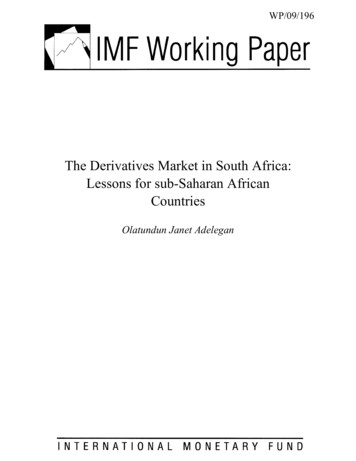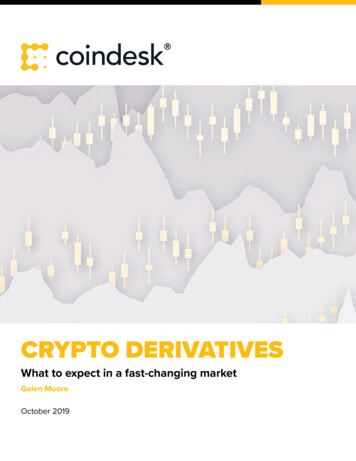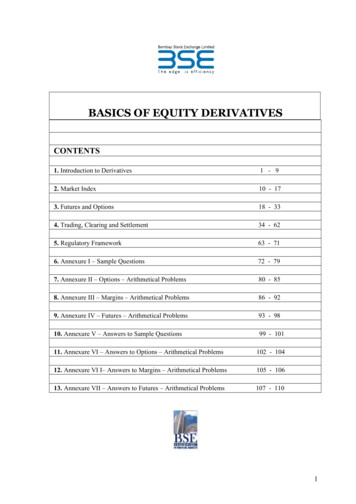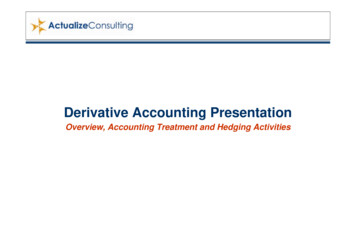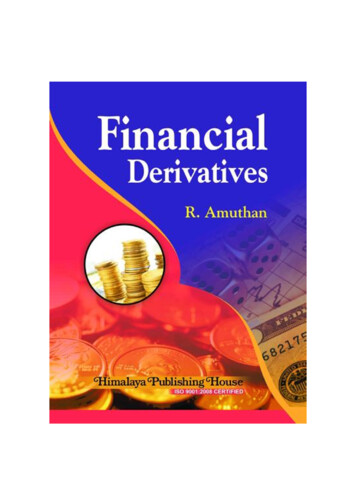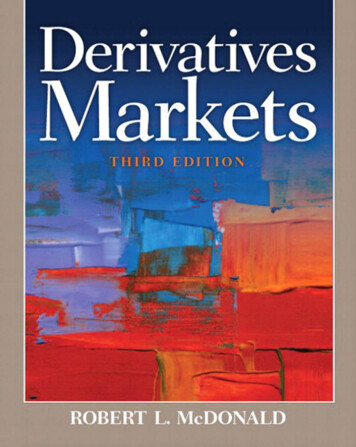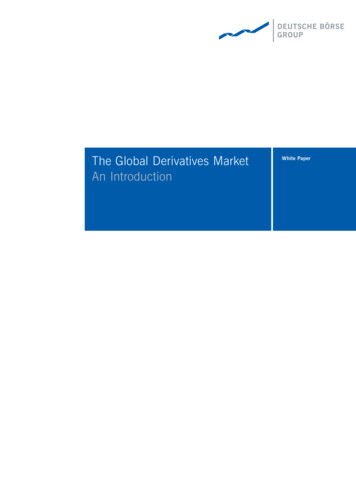
Transcription
The Global Derivatives MarketAn IntroductionWhite Paper
The Global Derivatives Market – An IntroductionTable of ContentsExecutive Summary41Introduction52Fundamentals and Market Characteristics62.12.22.32.43Basics of derivativesDevelopment of the market and Europe’s roleThe derivatives trading value chainCompetition in the global derivatives marketImperatives for a Well-Functioning Derivatives Market3.1 Safety and effective risk mitigation3.2 Innovation3.3 Efficiency4ConclusionList of ExhibitsGlossaryReferencesList of Abbreviations61014192323273032343540423
4The Global Derivatives Market – An IntroductionExecutive SummaryDerivatives are an important class of financial instruments that are central to today’s financial and trademarkets. They offer various types of risk protectionand allow innovative investment strategies.Around 25 years ago, the derivatives market wassmall and domestic. Since then it has grown impressively – around 24 percent per year in the lastdecade – into a sizeable and truly global market withabout 457 trillion of notional amount outstanding.No other class of financial instruments has experienced as much innovation. Product and technologyinnovation together with competition have fuelled theimpressive growth that has created many new jobsboth at exchanges and intermediaries as well as atrelated service providers. As global leaders driving themarket’s development, European derivatives playerstoday account for more than 20 percent of the European wholesale financial services sector’s revenuesand contribute 0.4 percent to total European GDP.Given the derivatives market’s global nature, userscan trade around the clock and make use of derivatives that offer exposure to almost any “underlying”across all markets and asset classes. The derivativesmarket is predominantly a professional wholesalemarket with banks, investment firms, insurancecompanies and corporates as its main participants.There are two competing segments in the derivativesmarket: the off-exchange or over-the-counter (OTC)segment and the on-exchange segment. Only around16 percent of the notional amount outstanding istraded on exchanges. From a customer perspective,on-exchange trading is approximately eight timesless expensive than OTC trading.By and large, the derivatives market is safe andefficient. Risks are particularly well controlled in theexchange segment, where central counterparties(CCPs) operate very efficiently and mitigate the risksfor all market participants. In this respect, derivativeshave to be distinguished from e.g. structured creditlinked security such as collateralized debt obligationsthat triggered the financial crisis in 2007.The derivatives market has successfully developedunder an effective regulatory regime. All threeprerequisites for a well-functioning market – safety,efficiency and innovation – are fulfilled. While thereis no need for structural changes in the frameworkunder which OTC players and exchanges operatetoday, improvements are possible. Particularly inthe OTC segment, increasing operating efficiency,market transparency and enhancing counterpartyrisk mitigation would help the global derivativesmarket to function even more effectively.
The Global Derivatives Market – An Introduction1 IntroductionMany associate the financial market mostly withthe equity market. The financial market is, of course,far broader, encompassing bonds, foreign exchange,real estate, commodities, and numerous other assetclasses and financial instruments. A segment of themarket has fast become its most important one:derivatives. The derivatives market has seen thehighest growth of all financial market segments inrecent years. It has become a central contributor tothe stability of the financial system and an importantfactor in the functioning of the real economy.Despite the importance of the derivatives market,few outsiders have a comprehensive perspectiveon its size, structure, role and segments and onhow it works.The derivatives market has recently attracted moreattention against the backdrop of the financial crisis,fraud cases and the near failure of some marketparticipants. Although the financial crisis has primarilybeen caused by structured credit-linked securitiesthat are not derivatives, policy makers and regulatorshave started to think about strengthening regulationto increase transparency and safety both for derivatives and other financial instruments.This paper aims to contribute an objective and factbased foundation to the ongoing debates concerningthe global derivatives market. Chapter 2 definesderivatives as a category of financial instrumentsand explains their benefits. It looks at the market’sdevelopment and functions and the role of Europeanplayers. It then elaborates on the derivatives tradingvalue chain and discusses the differences betweenOTC and on-exchange derivatives trading. Chapter 2concludes with a review of competitive dynamics inthe derivatives market. Chapter 3 discusses and assesses the prerequisites for a well-functioning derivatives market that benefits its users and the economy:effective risk mitigation, innovation and efficiency.Chapter 4 draws overall conclusions.5
6The Global Derivatives Market – An Introduction2 Fundamentals and Market CharacteristicsBefore discussing the prerequisites for a wellfunctioning derivatives market, it is useful to consider some fundamentals and characteristics of themarket. First the basics of derivatives are explained(2.1). Then the size, growth and function of thederivatives market and the role of European playersare discussed (2.2). This is followed by an explanation of the derivatives trading value chain (2.3).The chapter concludes with a review of competitivedynamics in the derivatives market (2.4).2.1 Basics of derivativesDerivatives are totally different from securities. Theyare financial instruments that are mainly used toprotect against and manage risks, and very oftenalso serve arbitrage or investment purposes, providing various advantages compared to securities.Derivatives come in many varieties and can bedifferentiated by how they are traded, the underlying they refer to, and the product type.Definition of derivativesA derivative is a contract between a buyer and aseller entered into today regarding a transaction tobe fulfilled at a future point in time, for example,the transfer of a certain amount of US dollars at aspecified USD-EUR exchange rate at a future date.Over the life of the contract, the value of the derivative fluctuates with the price of the so-called “underlying” of the contract – in our example, the USD-EURexchange rate. The life of a derivative contract, thatis, the time between entering into the contract andthe ultimate fulfillment or termination of the contract,can be very long – in some cases more than tenyears. Given the possible price fluctuations of theunderlying and thus of the derivative contract itself,risk management is of particular importance.1)Derivatives must be distinguished from securities,where transactions are fulfilled within a few days(Exhibit 1). Some securities have derivative-likecharacteristics – such as certificates, warrants, orstructured credit-linked securities – but they are notderivatives.2)This white paper focuses on the largest segmentof the derivatives market: derivatives contracts forwholesale and professional users. The fundamentalsexplained in this document mostly apply to bothwholesale and retail markets, although the share ofretail users is negligible in most markets.3) Derivativescontracts can be traded on derivatives exchangesbut also bilaterally between market participants. Thelatter segment – i.e. the OTC segment – currentlyaccounts for around 84 percent of the derivativesmarket (Exhibit 2).4)Uses and users of derivativesDerivatives make future risks tradable, which givesrise to two main uses for them. The first is toeliminate uncertainty by exchanging market risks,commonly known as hedging. Corporates andfinancial institutions, for example, use derivatives toprotect themselves against changes in raw materialprices, exchange rates, interest rates etc., as shownin the box below. They serve as insurance againstunwanted price movements and reduce the volatilityof companies’ cash flows, which in turn results inmore reliable forecasting, lower capital requirements,and higher capital productivity. These benefits haveled to the widespread use of derivatives: 92 percentof the world’s 500 largest companies manage theirprice risks using derivatives.5)1) Risk management in the derivatives market is discussed in detail in Chapter 3,section 3.1.2) It is particularly important to note that structured credit-linked securities andother asset-backed securities, which originally triggered the financial crisis in2007, are not derivatives.3) Retail investors only play a role in equity-linked derivatives and then particularly in single-equity instruments (see International Options Markets Association 2006, p. 10). Assuming a market share for retail investors of 50 percentin single-equity derivatives and of 20 percent in equity-index derivatives, thetotal market share of retail investors is below 1 percent in terms of notionalamount outstanding.4) The difference between OTC and on-exchange derivatives is explained below.5) See International Swaps and Derivatives Association 2003, p. 1.
The Global Derivatives Market – An IntroductionExhibit 1: Overview of financial instruments derivatives 2)Certifi cates (e.g. index or bonus certifi cates)WarrantsFunds /UCITSEquitiesWholesale /professionalBondsETFs1)Funds / UCITSFixed-income derivativesEquity-linked derivativesCommodity derivativesStructured creditlinked securities(CDOs, CLOs,MBS etc.)Other ABSForeign exchangederivativesCredit derivativesFocus of White Paper1) Exchange-traded funds2) Only relevant in few regions, e.g. equity options in US, the Netherlands and equity index futures and options in Korea; negligible in most of EuropeExhibit 2: Breakdown of the global derivatives market – OTC versus on-exchange and by underlying asset class1)Notional amount outstanding as of June 2007Underlying asset .4208.3103.71.60TotalFixed-incomeForeign exchangeCredit1) Exotic underlyings (e.g. weather, freight rates, economic indicators) account for less than 0.1 percent.Source: BIS, WFE, FIAEquityCommodities7
8The Global Derivatives Market – An IntroductionThe second use of derivatives is as an investment.Derivatives are an alternative to investing directly inassets without buying and holding the asset itself.They also allow investments into underlyings and risksthat cannot be purchased directly. Examples includecredit derivatives that provide compensation payments if a creditor defaults on its bonds, or weatherderivatives offering compensation if temperatures ata specified location exceed or fall below a predefinedreference temperature.Derivatives also allow investors to take positionsagainst the market if they expect the underlying asset to fall in value. Typically, investors would enterinto a derivatives contract to sell an asset (such asa single stock) that they believe is overvalued, ata specified future point in time. This investment issuccessful provided the asset falls in value. Suchstrategies are extremely important for an efficientlyfunctioning price discovery in financial markets asthey reduce the risk of assets becoming excessivelyunder- or overvalued.7)Benefits of derivatives make them indispensable tothe global financial system and the economyDerivatives contracts are mainly designed for professional users. Exchange-traded derivatives contractsare typically in the range of 20,000 to 1 millionnotional.8) Financial institutions and corporates therefore make up the majority of derivatives users – morethan 90 percent for some underlyings9) (Exhibit 3).Derivativesprovide risk protection with minimal upfrontinvestment and capital consumption.allow investors to trade on future priceexpectations.have very low total transaction costs comparedto investing directly in the underlying asset.allow fast product innovation because newcontracts can be introduced rapidly.can be tailored to the specific needs of any user.Derivatives have not only widened the investmentuniverse, they have also significantly lowered thecost of investing. The total transaction cost of buyinga derivatives contract on a major European stockindex is around 60 percent lower than that of buyingthe portfolio of underlying shares.6) If one comparesthe cost of gaining exposure to less liquid assetssuch as real estate, the cost differential between thederivative and the direct investment in the underlyingis even significantly higher.6) Comparison based on the exchange fees (direct costs), bid-ask spread andmarket impact costs (indirect costs) for gaining a 500,000 exposure to theDow Jones EURO STOXX 50 portfolio7) For a review of literature cf. Mayhew (2000)8) With the notable exception of single stock options and future, which have astandard contract size of around 2,000 to 5,0009) Based on estimates for the revenue split across customer categories of OTCderivatives dealers from McKinsey 2007
The Global Derivatives Market – An IntroductionExample: Derivatives can eliminate uncertainty and reduce market risksA European manufacturer sells solar modules to aCalifornian utility company for US 15 million. Thesale is agreed in January 2008 with delivery andpayment scheduled for November 2008. In January, 1 equals US 1.50, so the contract is worth 10million. The manufacturer pays his material and labour costs in euros, so it is important that he protectshimself against a fall in the US dollar relative to theeuro. Therefore, he enters into a derivative contracton the US dollar with his bank as the counterparty.The contract gives him the obligation to sell US 15million at an exchange rate of US 1.50 per euro tohis bank in November 2008.If the US dollar falls to US 2 per euro by November2008, the US 15 million will only be worth 7.5million to the manufacturer. The derivatives contractprotects against this potential loss: the manufacturerreceives 10 million from the bank in November2008, as originally agreed, for the US 15 million,despite the dollar’s severe depreciation.Exhibit 3: Customer breakdown of OTC derivatives dealers’ revenues by underlying asset classEuropean revenues 2006 1)%10090161064613807012333593160Public sector /Other643612High net worth ed-incomeForeignexchange2)Credit1) Based on reported revenue split from McKinsey 2007 (partially estimated)2) Including spot trading revenuesSource: McKinseyEquityCommoditiesFund-linkedFinancial institutions9
10The Global Derivatives Market – An IntroductionTypes of derivativesDerivatives can be traded OTC or on exchanges. OTCderivatives are created by an agreement between twoindividual counterparties. OTC derivatives cover arange from highly standardized (so-called “exchangelook-alike”) to tailor-made contracts with individualizedterms regarding underlying, contract size, maturityand other features. Most of these contracts are held tomaturity by the original counterparties, but some arealtered during their life or offset before termination.Derivatives can be differentiated along three maindimensionsType of derivative and market place: Derivativescan be traded bilaterally OTC (mostly individuallycustomized contracts) or multilaterally on exchanges(standardized contracts).Type of underlying: Underlyings can be financialinstruments themselves, physical assets, or any riskfactors that can be measured. Common examplesare fixed-income, foreign exchange, credit risk,equities and equity indices or commodities(Exhibit 2). Exotic underlyings are, for example,weather, freight rates, or economic indicators.Type of product: The three main types are forwards(or futures), options and swaps.10) They differ interms of their dependence on the price of theunderlying.10) See glossary for a detailed explanation of forwards, futures, options and swaps.Exchange-traded derivatives, on the other hand,are fully standardized and their contract terms aredesigned by derivatives exchanges. Most derivativesproducts are initially developed as OTC derivatives.Once a product matures, exchanges “industrialize” it,creating a liquid market for a standardized and refinedform of the new derivatives product. The OTC andexchange-traded derivatives then coexist side by side.The number of OTC-traded derivatives is unlimited inprinciple as they are customized and new contractsare created continuously. A broad universe of exchange-traded derivatives exists as well: for example,over 1,700 different derivatives are listed on thethree major global derivatives exchanges (ChicagoMercantile Exchange, Eurex and Euronext.Liffe).11)2.2 Development of the market and Europe’s roleThe derivatives market has grown rapidly in recentyears as the benefits of using derivatives, such as effective risk mitigation and risk transfer, have becomeincreasingly important. Europe is by far the mostimportant region for derivatives that have become amajor part of the European financial services sectorand a major direct and indirect contributor to economic growth.11) FIA statistics for US and international exchanges, press statements byderivatives exchanges
The Global Derivatives Market – An IntroductionExhibit 4a: Size and growth of the global derivatives,equity and bond marketsExhibit 4b: Average annual growth rate1995 – 20071)June 2007Derivatives outstandingOther financial instruments trillions%5004574007430243002002010055x t value 1)Equity market Bond marketcapitalization 2) capitalizationOn-exchangeOTC1) Gross market value defined as sum of the positive market values of allderivatives contracts outstanding (as defined by BIS); theoretic values foron-exchange segment estimated based on conversion factors for OTC products2) As of December 2007Source: BIS, WFESize and growth of the marketThe derivatives market is the largest single segmentof the financial market. As of June 2007, the globalderivatives market amounted to 457 trillion in termsof notional amount outstanding.12) By this measure,the derivatives market is more than four times largerthan the combined global equity and bond marketsmeasured by market capitalization. However, theestimated gross market values of all derivatives outstanding total only 10 trillion, which is markedlylower than the equity and bond markets with amarket capitalization of 43 trillion and 55 trillion,respectively (Exhibit 4a).13) The derivatives marketis the fastest growing segment of the financialDerivativesnotional amountoutstanding 2)Equity marketcapitalizationBond marketcapitalization1) Based on historic USD-EUR exchange rates; growth rates would be similarbased on USD values2) Estimate excluding on-exchange commodity and single-stock derivativesSource: BIS, WFEsector: since 1995, its size has increased by around24 percent per year in terms of notional amountoutstanding, far outpacing other financial instrumentssuch as equities (11 percent) and bonds (9 percent)(Exhibit 4b).14)12) See BIS 2008; the notional amount of a derivatives contract refers to the valueor nominal amount of the underlying to the derivatives contract; outstandingrefers to open derivatives contracts that are held by market participants.13) See BIS 2008 and WFE statistics (www.world-exchanges.org); the grossmarket value of a derivatives contract refers to the positive market value oneside of a derivatives contract has, not considering negative market values theother side to the derivatives contract might have. In contrast to notionalamount, gross market value reflects more the aggregated net risk position ofmarket participants and is therefore significantly lower.14) See BIS 2008 and BIS statistics (www.bis.org /statistics /derstats.htm).11
12The Global Derivatives Market – An IntroductionAs described, the OTC segment accounts for almost84 percent of the market with around 383 trillionof notional amount outstanding.15) Recently, however, the exchange segment has grown faster thanthe OTC segment. This is widely perceived to be aresult of the increasing standardization of derivativescontracts which facilitates exchange trading. Othercontributing factors are a number of advantagesof on-exchange trading: price transparency, riskmitigation and transaction costs are among themost important (see chapter 3).16)Global nature of the marketThe OTC segment operates with almost completedisregard of national borders.17) Derivatives exchangesthemselves provide equal access to customers worldwide. As long as local market regulation does notimpose access barriers,18) participants can connectand trade remotely and seamlessly from around theworld (e.g. from their London trading desk to theEurex exchange in Frankfurt). The fully integrated,single derivatives market is clearly a reality withinthe European Union.Taken as a whole, the derivatives market is trulyglobal. For example, today almost 80 percent of theturnover at Eurex, one of Europe’s major derivativesexchanges, is generated outside its home markets ofGermany and Switzerland, up from only 18 percentten years ago.Europe’s leading role within the derivatives marketToday, Europe is the most important region in theglobal derivatives market, with 44 percent of theglobal outstanding volume – significantly higherthan its share in equities and bonds (Exhibit 5).19)The global OTC derivatives segment is mainly basedin London. Primarily due to principle-based regulation, which provides legal certainty as well asflexibility, the OTC segment has developed especiallyfavourably in the UK’s capital.20) The unrestrictedpan-European provision of investment services, inplace since the introduction of the European Union’sInvestment Services Directive (ISD) in January1996,21) has strengthened the competitive positionof Europe in the global market environment. ManyEuropean banks are currently global leaders inderivatives.22)Historically, large derivatives exchanges were almostexclusively located in the US.23) Strong European derivatives exchanges appeared only after deregulationand demutualization in the 1980s and 1990s. TheseEuropean exchanges were more independent of theirusers, who had been less supportive of significantchanges at US exchanges. They revolutionized tradingby introducing fully electronic trading and by settingindustry standards. Over the years European playershave strengthened their position, increasing theirglobal market share from 24 percent in 1995 toalmost 40 percent in 2007.24) They are now amongthe largest exchanges worldwide in a sector wherethe biggest players are international exchange groupsthat offer trading globally.15) See BIS 2008.16) “An important trend is the shift towards increasingly higher volumes ofderivatives being traded on exchanges according to pre-established rules.The emergence of central clearing houses is removing the counterparty riskprevalent in OTC deals. Derivatives instruments are also being standardized,thereby facilitating electronic and exchange-based trading on set contracts.”(European Capital Markets Institute 2006, p. 50)17) Already in 1996, more than half of the trades were cross-border, emphasizing“the global nature of the market” (see BIS 1996, p. 2).18) The United States continues to restrict the direct offering of certain services toUS investors by foreign (derivatives) exchanges and clearing houses. This,however, is currently being reviewed in the debate of mutual regulatoryrecognition (see United States Securities and Exchange Commission 2007).19) See BIS 2008 and WFE statistics (www.world-exchanges.org).20) See City of New York/US Senate 2006.21) The ISD is the predecessor of MiFID.22) For example, in the Institutional Investor OTC Derivatives User Survey 2007,six European players feature in the top ten receiving almost 60 percent of thetop ten votes.23) Some US players like CME Group, NYMEX and NYBOT have their roots in the19th century.24) December 1995 vs. September 2007; in terms of notional amount outstanding; see BIS 2008 and BIS statistics (www.bis.org/statistics/derstats.htm).
The Global Derivatives Market – An IntroductionExhibit 5: Regional breakdown of the global derivatives, equity and bond marketsJune 2007Derivatives 1)Equities 2)Not. amountoutstanding trillionsMarket shareEurope44%39%North America13%AsiaRest of the worldTotal4%Market tion trillionsMarketcapitalization trillionsMarket share37%121541%14218%4%432023102551) Regional split for OTC derivatives according to underlying equity, currency of underlying interest rate, and currency of foreign exchange derivatives2) As of December 2007Source: BIS, WFEFrom a user perspective, the location of an OTCtrading desk or a derivatives exchange is usuallyirrelevant. From a more general viewpoint, however,the location of the market activity – trading desks,electronic OTC marketplaces, exchanges and clearinghouses – does matter. The derivatives industry is animportant and growing part of the financial servicessector and generates economic growth, tax revenuesand employment. Europe benefits in particular fromits strong players in this segment. The contribution ofEuropean derivatives players to GDP was over 41billion or about 0.4 percent in 2006.25) In 2005 theEuropean derivatives industry accounted for morethan 20 percent of the European wholesale financialservices sector’s revenues and over 20,000 jobs inEurope’s financial centers.26)In addition, the derivatives industry has significantindirect impact, such as generating employment atrelated service firms.The derivatives market also plays an importantrole for the European financial market and broadereconomy. It contributes to the increase of operational, information, price, valuation and allocationefficiency.27)25) Based on McKinsey 200726) The European wholesale financial services sector’s economic activity isestimated to amount to almost 200 billion (see CEBR/City of London 2007).27) See Tobin 1984, Bienert 1996 and Mayhew 2000.13
14The Global Derivatives Market – An IntroductionThe exchange segment makes an especially strongcontribution to operational and price efficiencythrough its multilateral market organization, equalaccess and public disclosure of prices supported byappropriate regulation. Efficient financial marketslower the cost of capital, enable firms to invest, andchannel resources to their most valuable uses. Studies show that efficiently functioning financial marketscan increase real GDP growth considerably.28) Thesepositive contributions of the derivatives market areespecially significant in Europe, as its size relative tothe rest of the financial market is much greater thanin other regions.29) The ratio of derivatives notionalamount outstanding to equity and bond marketcapitalization is 6.2 for Europe, compared to 4.8for North America and just 2.5 for Asia.Europe’s leadership in derivatives has not gone unnoticed. The continued success of European OTCand exchange players has prompted reactions especially in the US. A highly acclaimed report by theCity of New York and the US Senate concluded thatthe US runs the risk of being overtaken by Europein the financial services industry. The report underlines that Europe is clearly leading in the derivativesmarket, which drives “broader trading flows and [.]the kind of continuous innovation that contributesheavily to financial services leadership.”30) Proposedmeasures – in part already implemented – try to address the emerging shortcomings of the US vis-à-visEurope in terms of “conditions for innovation, capitalformation, risk management and investment in these[debt and derivatives] markets.”31)2.3 The derivatives trading value chainDerivatives trading and clearing is organized differently for OTC and on-exchange derivatives. Themain distinguishing feature is the multilateral marketorganization with the use of safe and efficient centralcounterparty clearing for derivatives being traded onexchanges.32)Functions in derivatives tradingThe derivatives value chain can be broken downinto derivatives pre-trading, derivatives trading andclearing (including the rare exercise of derivatives),and (also rare) payment and delivery (Exhibit 6).These functions are organized differently for OTC andexchange-traded derivatives. Broker-dealers (largeinvestment or universal banks), exchanges and clearing houses are the main service providers along thevalue chain.Pre-trading comprises the origination and channellingof derivatives orders to marketplaces for the executionof transactions.Trading consists of the matching of buyers and sellers in derivatives contracts. Execution means thatthe buyer and the seller respectively enter into thederivatives contract.33) Often dedicated derivativesdealers constantly provide price offers for contracts.This is called market making34) and is also a part oftrading.35)A derivatives trade creates an “open” derivativescontract. Derivatives clearing manages these “open”contracts until their termination, and is closely linkedto derivatives trading as “open” contracts can betraded again and need to be managed throughoutthe contracts’ – potentially very long – maturities.28) See Carmichael/Pomerleano 2002, Levine 1997 and Domowitz/Steil 2002.29) See BIS 2008, McKinsey Global Institute 2005 and WFE statistics(www.world-exchanges.org).30) One of the reasons cited is Europe’s innovativeness: “Europe is [ ] the centerfor derivatives innovation”. (City of New York/US Senate 2006, p. 56)31) See City of New York/US Senate 2006, p. 54.32) CCP clearing is also used to a minor extent for OTC-traded derivatives.33) As derivatives contracts
2.3 The derivatives trading value chain 14 . 60 70 80 10 100 0 77.0 9.4 8.3 3.7 1.6 Total Fixed-income Foreign exchange Credit Equity Commodities . Underlying asset class. 8 The Global Derivatives Market - An Introduction The second use of derivatives is as an investment. Derivatives are an alternative to investing directly in assets .


